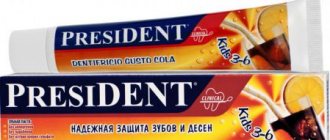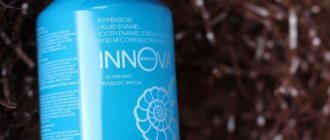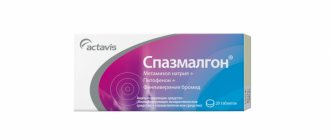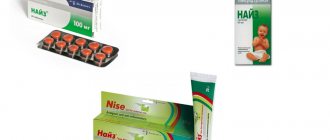What to do if your child has a fever? This question sooner or later arises in every parent who is concerned about the health of their child. But not all mothers and fathers know what temperature can and should be lowered. So, for example, in newborns and babies up to one year old the indicator is up to 37.5-38 degrees, which for us adults is considered elevated, and is the norm. The baby is one month old – does he have a fever? Reduce it only if it rises above 38-38.5.
As for older toddlers, for them this “threshold” is 39-39.5. If the thermometer shows a lower temperature, you should not knock it down. Remember that a child’s fever is an excellent opportunity for the body to fight the infection on its own. Give your baby the opportunity to boost his immunity!
Side effects
When using the drug, the following side effects are rarely possible:
From the gastrointestinal tract: nausea, vomiting, discomfort or pain in the epigastrium, laxative effect, the occurrence of erosive and ulcerative lesions, bleeding.
From the nervous system: headache, dizziness, psychomotor agitation, insomnia.
From the hematopoietic organs: anemia, thrombocytopenia, agranulocytosis, leukopenia.
From the urinary system: impaired renal function, cystitis.
Allergic reactions: skin rash, itching, urticaria, exacerbation of bronchial asthma, angioedema, anaphylactoid reactions, anaphylactic shock, bronchospasm, fever, erythema multiforme exudative (including Stevens-Johnson syndrome), toxic epidermal necrolysis (Lyell's syndrome).
From the cardiovascular system: tachycardia, increased blood pressure.
How to reduce a child's temperature?
Doctors advise using only one drug from the above - with Paracetamol or Ibuprofen in the composition. If the temperature drops poorly or does not drop at all, such medications can be alternated. But you can’t give your baby the combined drug Ibuklin.
Please note that it is not at all necessary to reduce the temperature to normal. It is enough just to knock it down a little for the baby’s well-being to improve at least a little. Don’t forget to feed your little one, because in case of high temperature the loss of fluid increases. Pediatricians say that babies need to drink 100 ml of water per 1 kg of weight.
Directions for use and doses
Rectally. The dosage for children depends on the age and body weight of the child.
Post-immunization fever: children under 1 year - 1 supp., over 1 year, if necessary, 1 more supp. in 6 hours
Fever and pain
Single dose - 5-10 mg/kg body weight 3-4 times a day. The maximum daily dose is no more than 30 mg/kg/day.
Children aged 3–9 months (5.5–8.0 kg) - 1 supp. (60 mg) 3 times within 24 hours every 6–8 hours, not more than 180 mg/day; from 9 months to 2 years (8.0–12.5 kg) - 1 sup. (60 mg) 4 times within 24 hours every 6 hours, but not more than 240 mg/day.
Duration of treatment: as an antipyretic - no more than 3 days; as a pain reliever - no more than 5 days.
If fever persists, you should consult your doctor.
How to reduce a child's temperature?
Now let’s talk about the medications that should definitely be in your first aid kit if a baby is growing up in the family. Thus, pediatricians prohibit the use of drugs such as:
- Aspirin;
- Analgin;
- Nise.
The baby can only be given medications that contain Paracetamol or Ibuprofen. Even if the child has no symptoms, they must be correctly calculated based on the baby’s weight and measured using a special syringe or measuring spoon. You should not use ordinary teaspoons for these purposes, and it is better to completely forget about the concept of “by eye”.
Consequences of an overdose of Nurofen
When taking too high a dose of Nurofen, various overdose symptoms may occur, which may result in the following health consequences :
- heart attack;
- heart failure;
- anemia (anemia);
- stomach and/or intestinal bleeding;
- the appearance of through holes in the gastrointestinal tract (perforation);
- inflammatory liver diseases (hepatitis);
- renal failure;
- bronchial asthma.
Therefore, it is extremely important not to exceed the daily dose of this drug, carefully study the instructions for the drug and not neglect the doctor’s recommendations.
Interactions of Nurofen™ for children
Concomitant use with:
- acetylsalicylic acid or with other NSAIDs and GCS drugs (the risk of side effects from the gastrointestinal tract increases);
- anticoagulants (increasing the effect of oral anticoagulants and increasing the risk of bleeding).
Use cautiously simultaneously with:
- antihypertensive drugs and diuretics (increased risk of developing a reaction from the kidneys);
- methotrexate and lithium drugs (increased levels of these drugs in the blood plasma);
- cyclosporines (drug interactions are possible, which can lead to an increased risk of nephrotoxicity).
What temperature should be lowered in a child with influenza and ARVI?
High temperature forces the child's body to turn on its protective function. In this case, there may be a general deterioration in the form of malaise and headaches. The child becomes lethargic and whiny, which brings a lot of anxiety to parents. Before bringing down a child’s high temperature, you need to clarify significant nuances.
A slight increase in temperature does not lead to serious consequences and does not require any measures to be taken. Parents need to have reliable information about what temperature should be lowered. Improper actions can cause weakened immunity. There is a risk of developing possible complications and the disease may become protracted.
Cases when you need to bring down the temperature in children:
- 37.2-37.9°C (low-grade fever) – should be taken for newborns up to 2 months of age if indicated;
- 38.0-38.9°C (febrile) – antipyretics must be given in all cases;
- over 41.0°C (hyperthermic) - you need to call an ambulance if the drugs do not lower the readings on the thermometer.
It is necessary to call an ambulance if febrile spasms appear - this is intolerance to high temperature, an individual feature of the child’s body. This condition usually does not occur in children over 6 years of age (provided there are no pathologies in the central nervous system).
Chronic or acute diseases in cardiology, neurology or lung disease require lowering the temperature in children if the readings are above 38°C. Otherwise, complications from the heart, nervous system and respiratory organs cannot be ruled out.
If you have difficulty lowering your temperature, you should immediately seek medical help. If the thermometer has barely reached 37°C, and the child looks lethargic and his health is only getting worse, you should not expect a further increase in the readings on the thermometer.
Symptoms of an overdose of Nurofen
You should immediately stop using Nurofen and consult a doctor immediately if you experience the following symptoms that may indicate an overdose of this drug:
- changes in vision (decreased clarity, distorted colors);
- shortness of breath (even with light exertion);
- swelling of the body or rapid weight gain;
- the first sign of any skin rash, no matter how mild;
- signs of stomach bleeding - bloody or tarry stools, coughing up blood, or vomit that looks like coffee grounds;
- evidence of liver problems - nausea, pain in the upper abdomen, feeling tired, loss of appetite, dark urine, clay-colored stools, jaundice (yellowing of the skin or eyes);
- signs of kidney problems - infrequent, little or no urination, painful or difficult urination, swelling of the legs or ankles, feeling tired or short of breath;
- low red blood cell count (anemia)—pale skin, dizziness or shortness of breath, fast heartbeat, trouble concentrating;
- for severe skin and mucous membrane reactions—fever, sore throat, swelling of the face or tongue, burning eyes, skin tenderness, followed by a red or purple skin rash that spreads, especially to the face or upper body, and causes blistering and peeling.
How to help a child’s body fight infection?
Regardless of whether you follow the recommendations on what temperature to lower in children, you must take care to create the necessary conditions for the patient. All family members should improve the quality of personal hygiene: wash their hands, wear disposable gauze bandages, etc. You also need to provide the child with separate cutlery and dishes.
Recommendations for a speedy recovery:
1. A sick child must remain in bed.
2. It is necessary to ventilate the room in which the baby is located (the influenza virus and other microorganisms are concentrated in musty air).
3. Care should be taken to humidify the air (at the same time, the mucous membranes of the nose and larynx do not dry out; this improves local immunity and promotes well-being).
4. You should ensure that you drink plenty of fluids (virus breakdown products are eliminated through the kidneys, which reduces the load on the body).
5. The baby’s clothes should be light, preferably made from natural fabrics.
6. It is considered normal for a baby to have no appetite. You should avoid spices, citrus fruits, and dairy products, which can cause irritation of the gastric mucosa. A hot bath at a high temperature is not the most pleasant feeling, but cool (not cold) water can help normalize the indicators.
7. It is recommended to use the bath together with antipyretics, and not instead of them. You can also get some relief by applying a cool compress to your forehead.
Pharmacological properties of the drug Nurofen™ for children
The mechanism of action is due to inhibition of the synthesis of prostaglandins - mediators of pain, inflammation and temperature response. The drug has analgesic, antipyretic and anti-inflammatory effects, inhibits platelet aggregation. After oral administration, it is quickly and almost completely absorbed from the digestive tract. The maximum concentration of the active substance in the blood plasma is achieved 1–2 hours after administration. Ibuprofen is 90–99% bound to plasma proteins and penetrates into the synovial fluid. Metabolized in the liver to two inactive metabolites, which are quickly and almost completely excreted by the kidneys. A certain amount (10%) is excreted unchanged. The half-life is 2 hours.
Buy Nurofen for children film-coated tablets 200 mg No. 8 in pharmacies
Instructions for use Nurofen Buy at the pharmacy Nurofen for children tablet p.o 200 mg No. 8 Dosage forms tablets 200 mg Synonyms Ibuprofen Ibufen Nurofen for children Group Anti-inflammatory drugs - derivatives of propionic acid International nonproprietary name Ibuprofen Composition Active substance: ibuprofen. Manufacturers Reckitt Benckiser Healthcare International Ltd (Great Britain) Pharmacological action Anti-inflammatory, analgesic, antipyretic. Non-selectively inhibits two isoenzymes of cyclooxygenase. The maximum concentration is created after 0.5-1 hour. Slowly penetrates into the joint cavity, but lingers in the synovial tissue, creating higher concentrations in it than in plasma. Subject to biotransformation. Excreted by the kidneys. The anti-inflammatory effect is associated with a decrease in vascular permeability, improvement of microcirculation, decreased release of inflammatory mediators from cells and suppression of energy supply to the inflammatory process. The analgesic effect is due to a decrease in the intensity of inflammation, a decrease in the production of bradykinin and its algogenicity. A decrease in the excitability of the heat-regulating centers of the diencephalon results in an antipyretic effect. With a single dose, the effect lasts up to 8 hours. It has an antipyretic effect, the severity of which depends on the initial body temperature and dose. Reversibly inhibits platelet aggregation. Side effects : Dyspeptic disorders (nausea, heartburn, anorexia, vomiting, discomfort in the epigastric region, flatulence, diarrhea, constipation), erosive and ulcerative lesions of the gastrointestinal tract with signs of gastrointestinal bleeding, headache, dizziness, tinnitus, insomnia, agitation, visual disturbances (blurred vision, changes in color vision), fluid retention, edema, increased blood pressure, thrombocytopenia, granulocytopenia, hemolytic anemia, Quincke's edema, broncho-obstructive syndrome, allergic skin reactions. Indications for use : Rheumatoid arthritis, reactive synovitis in osteoarthritis deformans, psoriatic arthritis, acute joint attack in gout, ankylosing spondylitis (Bechterew's disease), cervical spondylosis, Barre-Lieu syndrome (cervical migraine, vertebral artery syndrome), lumbodynia, sciatica, thoracic radicular syndrome, bursitis, tenosynovitis, myalgia, neuralgic amyotrophy, occipital and intercostal neuralgia, ligament sprains, hematomas, trauma, pain in the surgical wound area, toothache, oral surgery, panniculitis, tonsillitis, pharyngitis, laryngitis, sinusitis, rhinitis , bronchitis, pneumonia, inflammatory processes in the pelvis, dysalgomenorrhea, colds, ARVI, febrile states, postural hypotension when taking antihypertensive drugs, nephrotic syndrome (to reduce the severity of proteinuria).
Dosage regimen
The drug is prescribed to adults and children over 12 years of age orally, after meals, in tablets of 200 mg 3-4 times a day. The tablets should be taken with water. To achieve a rapid therapeutic effect in adults, the dose can be increased to 400 mg (2 tablets) 3 times a day. Children from 6 to 12 years old: 1 tablet no more than 4 times a day; the drug can only be used if the child weighs more than 20 kg. The interval between taking tablets is at least six hours. Do not take more than 6 tablets in 24 hours. The maximum daily dose is 1200 mg. If symptoms persist after taking the drug for 2-3 days, you should stop treatment and consult a doctor.
Contraindications Hypersensitivity, peptic ulcer of the stomach and duodenum in the acute phase, nonspecific ulcerative colitis, aspirin-induced asthma, leukopenia, thrombocytopenia, hemorrhagic diathesis, severe dysfunction of the liver and kidneys, portal hypertension, arterial hypertension, heart failure, diseases of the optic nerve, scotoma , amblyopia, color vision impairment, pregnancy, breastfeeding. Overdose Symptoms: abdominal pain, nausea, vomiting, lethargy, drowsiness, depression, headache, tinnitus, metabolic acidosis, coma, acute renal failure, hypotension, bradycardia, tachycardia, atrial fibrillation and respiratory arrest. Treatment: gastric lavage (only during the first hour after administration), activated charcoal (to reduce absorption), alkaline drinking, forced diuresis and symptomatic therapy (correction of acid-base status, blood pressure, gastrointestinal bleeding). Interaction Reduces the antihypertensive activity of ACE inhibitors, the natriuretic activity of furosemide and hypothiazide. May increase the toxicity of methotrexate and lithium preparations. When combined with coumarin-type anticoagulants and alcohol, it increases the risk of hemorrhagic complications, and with tableted glucocorticoids - the risk of gastrointestinal bleeding. It is not recommended to use simultaneously with acetylsalicylic acid or other NSAIDs, antidiabetic drugs, phenytoin and hormonal contraceptives. Increases the concentration of digoxin in plasma. Caffeine enhances the analgesic effect of ibuprofen. Special instructions Considering the possibility of developing NSAID gastropathy, it is prescribed with caution to elderly people with a history of stomach ulcers and other gastrointestinal diseases, gastrointestinal bleeding, with simultaneous therapy with glucocorticoids, other NSAIDs and for long-term therapy. When symptoms of gastropathy appear, careful monitoring is indicated (including esophagogastroduodenoscopy, blood test to determine hemoglobin, hematocrit, stool test for occult blood). To prevent the development of NSAID gastropathy, it is recommended to combine it with PGE drugs (misoprostol). Prescribed with caution in children (up to 12 years), patients with severely impaired liver and kidney function (regular monitoring of bilirubin levels, transaminases, creatinine, renal concentrating ability is required), arterial hypertension and chronic heart failure (daily monitoring of diuresis, body weight , blood pressure). If visual impairment occurs, the dose should be reduced or the drug discontinued. It is not recommended to consume alcoholic beverages during treatment. Storage conditions List B. In a place protected from light at room temperature.
What to do if your child has a fever?
Does your baby have a fever? Then you can’t hesitate - you need to urgently consult a doctor. Especially if it is accompanied by:
- rash;
- neck muscle tension;
- abdominal pain;
- vomiting.
But don’t panic: fever is typical for most common viral respiratory infections and high temperatures - about 40 degrees. This is how our body responds to infection. The pediatrician will simply examine the child and select the right treatment for him, taking into account the severity of the disease.









